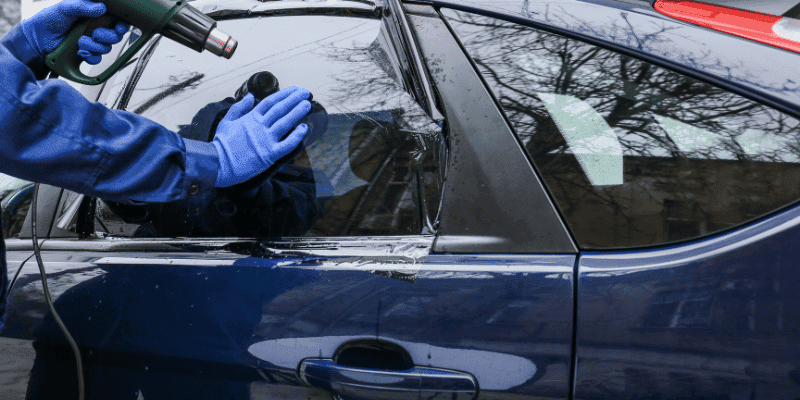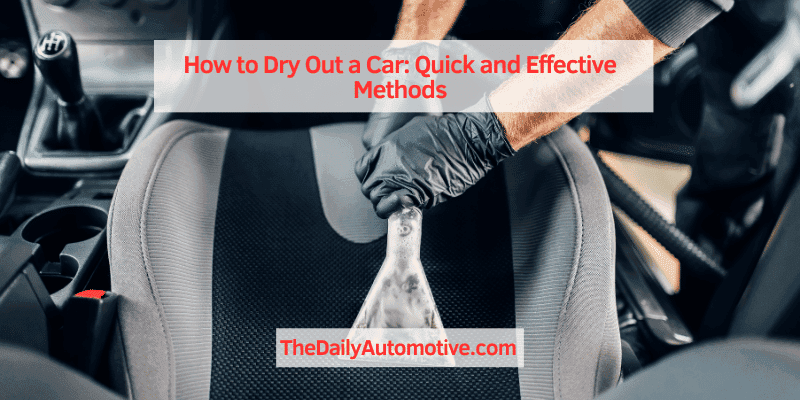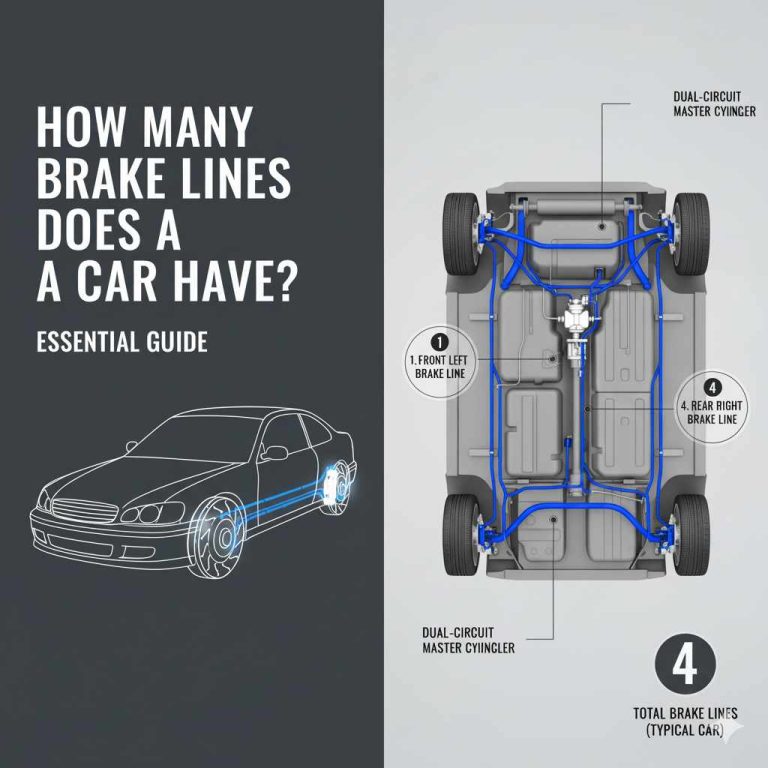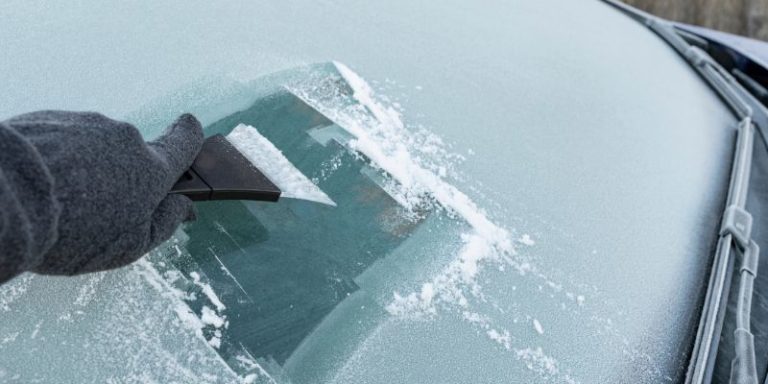How to Dry Out a Car: Quick and Effective Methods
To dry out a car, use a combination of towels and air circulation. Remove excess water with towels, open windows and doors, and use fans or a dehumidifier for improved air circulation.
This will help to remove moisture and prevent mold and mildew growth. Properly drying out a car is essential after it has been exposed to water, whether due to a heavy rainstorm, a car wash, or even a flood. Excess moisture can lead to unpleasant odors, damage to the interior, and the growth of mold and mildew.
To prevent these issues, it is important to take immediate action to dry out the car thoroughly. By using a combination of towels and improving air circulation, you can effectively remove excess water and moisture from your car. This article will outline the steps you need to take to ensure your car is dried out properly, leaving it clean, dry, and free from potential damage.

Assessing The Damage
Assessing the damage: learn effective methods to quickly dry out your car after it has been exposed to water damage. These simple yet essential steps will help prevent further issues and restore the integrity of your vehicle.
Check For Standing Water Inside The Car
Inspecting and removing any standing water inside your car is the first crucial step in the process of drying it out. Here’s what you need to do:
- Begin by opening all the doors and windows of the car to allow for proper ventilation.
- Carefully check the floors, footwells, and trunk for any visible puddles or standing water.
- Use towels, mops, or a wet/dry vacuum cleaner to soak up and remove the water as much as possible.
- Pay close attention to hard-to-reach areas like under the seats and in the corners of the trunk.
- Make sure to address any water accumulation in the spare tire well or trunk compartments.
Inspect The Upholstery And Carpet For Moisture
Moisture trapped in the upholstery and carpets can lead to mold and mildew growth if not addressed promptly. Follow these steps to assess the extent of moisture in your car’s interior:
- Run your hands over the seats, feeling for dampness or sponginess.
- Examine the floor mats, checking for wetness underneath and squeezing them to detect moisture.
- Use a moisture meter or a clean, white cloth to dab different areas of the upholstery and carpet, assessing the level of moisture absorbed.
- Inspect the headliner, dashboard, and door panels for any signs of water or visible moisture.
Evaluate The Extent Of Water Damage In The Interior
Now that you’ve checked for standing water and assessed the moisture in the upholstery and carpets, it’s time to evaluate the overall water damage inside the car. Consider the following:
- Look for discoloration, warping, or peeling of panels or trim, indicating prolonged exposure to water.
- Check electrical components such as buttons, switches, and gauges to ensure they are functioning properly.
- Take note of any musty odors, as they may suggest hidden areas of trapped moisture.
- Inspect the glove compartment, center console, and cup holders for signs of water damage.
By thoroughly assessing the damage caused by water, you can determine the appropriate steps to take for drying out your car effectively. Remember, the sooner you address the water damage, the better chance you have of preventing further issues like mold growth and odors.
Removing Excess Moisture
Learn how to effectively remove excess moisture from your car with these simple tips. From using absorbent materials to proper ventilation, you can easily dry out your car and prevent potential damage caused by moisture buildup.
Open All Doors And Windows To Allow Airflow
- To begin the process of drying out a car, it is crucial to open all doors and windows in order to facilitate airflow. This will help in reducing the excess moisture inside the vehicle.
- By allowing fresh air to circulate, the dampness inside the car will gradually dissipate, aiding in the drying process.
- Ensure that all windows and doors are opened wide enough to create a sufficient airflow throughout the interior of the car.
- Do not forget to remove any personal belongings or valuables from the vehicle before leaving the doors and windows open.
Use A Wet/Dry Vacuum To Extract Water From Carpets
- A wet/dry vacuum cleaner is an extremely useful tool when it comes to removing excess water from car carpets.
- Begin by locating the areas on the carpet where water has accumulated the most.
- Attach the appropriate nozzle to the wet/dry vacuum cleaner and carefully vacuum the wet spots. Be thorough in your approach to ensure all the water is extracted.
- Move the nozzle back and forth over the damp areas, applying gentle pressure to allow the vacuum to effectively suction the water.
- Repeat this process until the carpets feel significantly drier. It may be necessary to repeat the vacuuming process multiple times in severely affected areas.
Wipe Down Surfaces With Absorbent Towels
- Another effective method to remove excess moisture from a car is to wipe down all surfaces with absorbent towels.
- Begin by identifying areas where moisture has accumulated, such as seats, dashboard, and console.
- Take a clean and absorbent towel and gently press it against the wet surface. Apply slight pressure, allowing the towel to absorb as much moisture as possible.
- Continue to wipe down all affected surfaces until they feel noticeably drier.
- It is crucial to ensure that the towels are regularly replaced or wrung out to maintain their absorbency.
By following these steps and taking the necessary precautions, you can effectively remove excess moisture from your car. Remember to allow sufficient airflow by opening all windows and doors, use a wet/dry vacuum to extract water from carpets, and wipe down surfaces with absorbent towels.
Drying Techniques For Different Areas
Discover effective drying techniques to efficiently dry out your car. From using absorbent towels to utilizing a microfiber drying cloth, learn how to keep your car spotless and moisture-free.
Drying The Upholstery And Seats:
When it comes to drying the upholstery and seats of your car, there are several techniques you can employ to remove moisture effectively. These techniques include:
- Using a portable fan to increase airflow around the seats: Place a portable fan near the wet areas, such as the upholstery and seats, to promote air circulation. This will help expedite the drying process.
- Applying absorbent materials to draw out moisture: Utilize materials like towels or paper towels to blot the wet areas. Press the absorbent material firmly against the upholstery and seats to draw out as much moisture as possible. Repeat this process with fresh towels until the majority of the moisture is removed.
Drying The Carpet:
Drying the carpet is crucial to prevent mold and mildew growth. Follow these steps to dry out the carpet efficiently:
- Removing the carpet and letting it air dry outside the car: If possible, remove the carpet from the car to facilitate faster drying. Lay it out in an open and well-ventilated area, preferably outside, where it can receive ample airflow and sunlight. Leave it to air dry completely before reinstalling it.
- Utilizing a dehumidifier to speed up the drying process: Place a dehumidifier inside your vehicle to extract excess moisture from the air. This will help accelerate the carpet drying process. Ensure that the car windows and doors are closed tightly while the dehumidifier is in operation.
Drying The Electrical Components:
Drying the electrical components of your car is crucial to avoid potential damage and ensure safe operation. Here’s what you need to do:
- Disconnecting and inspecting the battery: Start by disconnecting the car battery to prevent any electrical issues. Inspect the battery for any signs of moisture, and dry it thoroughly before reconnecting.
- Using a hairdryer on a low setting to dry out exposed wires: Carefully use a hairdryer on a low heat setting to dry out any exposed wires in the electrical system. Ensure that the hairdryer is not too close to the wires to avoid overheating. Take your time to dry each wire properly, ensuring there are no lingering moisture spots.
Remember, by following these effective drying techniques for different areas of your car, you can minimize potential damage and restore your vehicle to a dry and safe condition.
Preventing Mold And Mildew Growth
To prevent mold and mildew growth in your car, it’s important to thoroughly dry it out. Remove any wet items, open the windows, and use fans or dehumidifiers to promote air circulation. Regularly cleaning and vacuuming can also help prevent moisture buildup.
Excess moisture in a car can lead to the growth of mold and mildew, causing unpleasant odors and potential health issues. To prevent these problems, follow these tips:
Applying An Anti-Microbial Spray To The Affected Areas:
- Purchase a high-quality anti-microbial spray: Look for a product specifically designed to combat mold and mildew.
- Identify the affected areas: Inspect the car’s interior thoroughly, paying attention to areas that may have become damp or wet.
- Spray the affected areas: Apply the anti-microbial spray generously, focusing on spots prone to mold and mildew growth such as carpets, seats, and the trunk.
- Allow the spray to sit: Leave the product on the surfaces for the recommended amount of time to effectively kill any existing mold or mildew spores.
- Wipe away excess spray: After the designated period, wipe the surfaces clean with a microfiber cloth or paper towels, making sure to remove any residue.
- Repeat if necessary: Depending on the severity of the moisture issue, you may need to apply the spray more than once to completely eliminate mold and mildew.
Using Silica Gel Packets To Absorb Excess Moisture:
- Obtain silica gel packets: Purchase or reuse packets that contain silica gel beads, commonly found in packages or products prone to humidity.
- Place the packets strategically: Position the packets in various areas of the car, such as the glove compartment, under the seats, or near the floor mats.
- Check and replace regularly: Monitor the silica gel packets regularly, as they will eventually become saturated with moisture. Replace them when necessary to maintain their effectiveness.
- Dispose of moisture: If the packets become soaked, dispose of them properly. Avoid opening them or letting the gel come into contact with your skin.
- Replenish as needed: Continuously use fresh silica gel packets to combat excess moisture and prevent mold and mildew growth.
Regularly Cleaning And Disinfecting The Car’S Interior:
- Vacuum the interior: Use a vacuum cleaner with attachments to remove any dirt, debris, or crumbs from the carpets, seats, and other surfaces.
- Wipe surfaces with disinfectant wipes: Use disinfectant wipes to clean frequently-touched areas, such as the steering wheel, door handles, and dashboard.
- Focus on fabric surfaces: Take extra care to clean fabric upholstery thoroughly, as moisture tends to get trapped and promote mold and mildew growth.
- Allow for proper ventilation: Whenever possible, open windows or doors to allow fresh air to circulate and aid in the drying process.
- Consider professional cleaning: If the moisture issue persists or mold and mildew growth is extensive, seek professional cleaning services to thoroughly sanitize and deodorize your car.
By taking these preventive measures and maintaining a dry environment, you can keep your car free from mold and mildew growth, ensuring a fresh and healthy driving experience.

Professional Help And Recommendations
Get professional help and recommendations on how to effectively dry out your car after it gets wet. Follow these simple steps to ensure your car’s interior is fully dried and avoid mold and mildew growth.
If your car has experienced extensive water damage, it is best to consult a professional car detailer. They have the expertise and equipment to properly dry out your vehicle and prevent any further damage. Here are some reasons why seeking professional help is important:
- Expert assessment: Car detailers have the knowledge and experience to assess the extent of the water damage in your car. They can determine the areas that need immediate attention and provide recommendations for the drying process.
- Proper equipment: Professionals have specialized tools and equipment that are specifically designed for drying out cars. They can use techniques such as high-powered fans, dehumidifiers, and moisture meters to effectively remove moisture from all areas of your vehicle.
- Prevent mold and odors: If water is not properly dried out, it can lead to mold growth and unpleasant odors in your car. Professional car detailers can ensure that all moisture is removed, reducing the risk of mold and eliminating any musty smells.
- Preservation of electrical components: Water damage can affect the electrical systems in your car. By consulting a professional, you can minimize the risk of electrical issues and prevent any potential hazards.
When it comes to electrical issues, it’s best to seek advice from a mechanic. They can inspect your car’s electrical components and address any issues that may have arisen due to water damage. Here’s why consulting a mechanic is essential:
- Diagnosing electrical problems: Mechanics have the knowledge and expertise to diagnose electrical issues in your car. They can identify any damaged components and determine the necessary repairs or replacements.
- Preventing further damage: Electrical issues can cause further damage if not addressed promptly. By seeking advice from a mechanic, you can prevent additional damage and ensure the safety and functionality of your car.
- Ensuring proper repairs: Attempting to fix electrical problems yourself can be risky and may result in improper repairs. By consulting a mechanic, you can ensure that the electrical issues are properly addressed and resolved.
Lastly, it’s worth considering comprehensive car insurance coverage for future incidents. Here are some reasons why comprehensive coverage is beneficial:
- Protection against water damage: Comprehensive coverage typically provides protection against water damage, ensuring that any future incidents are covered.
- Financial peace of mind: Insurance coverage can provide financial protection in case your car sustains water damage. It can cover the cost of repairs, helping you avoid significant financial burdens.
- Additional coverage: Comprehensive insurance often includes coverage for other incidents such as theft, vandalism, and natural disasters. This comprehensive protection ensures that you are prepared for various situations.
Having professional help, seeking advice from a mechanic, and considering comprehensive car insurance coverage can greatly assist you in drying out your car, addressing electrical problems, and protecting against future incidents.
Frequently Asked Questions Of How To Dry Out A Car
How Do You Get Moisture Out Of A Car?
To remove moisture from a car, follow these steps:
1. Open all the windows and doors to allow fresh air to circulate, helping to dry out the interior.
2. Use absorbent materials like towels or paper towels to wipe off any visible moisture on the seats, floor mats, or windows.
3. Place moisture-absorbing products, such as silica gel packets or charcoal briquettes, inside the car. They’ll draw moisture from the air and help reduce dampness.
4. Consider using a dehumidifier or leaving the car in a well-ventilated area with low humidity.
This will further aid in removing moisture.
5. Regularly check for and repair any leaks in your car’s windows, sunroof, or door seals, as these can contribute to excessive moisture.
6. Finally, clean and thoroughly dry any wet or damp upholstery to prevent mold and mildew growth.
By following these steps, you can effectively remove moisture from your car, making it more comfortable and preventing potential damage.
Is It Okay To Let the Car Air Dry?
Yes, it is fine to let your car air dry.
How Do You Dry Out A Wet Car Floor?
To dry out a wet car floor, start by removing any visible water using towels or a wet/dry vacuum. Then, open the car doors and windows to allow air circulation. Place fans inside the car to speed up the drying process.
If the car has carpeting, remove it and hang it to dry outside. Use a dehumidifier in the car to absorb moisture from the air. To prevent mold and mildew, sprinkle baking soda on the carpet and upholstery and vacuum it up after a few hours.
If the wetness persists, consider using a moisture-absorbent product like silica gel or kitty litter. Finally, inspect for any leaks in the car and address them promptly to prevent future water damage.
How Long Does It Take To Dry Out A Car?
The time it takes to dry out a car depends on the severity of the moisture and the methods used. It can take anywhere from a few hours to several days. Factors like weather conditions and ventilation also play a role in the drying process.
Conclusion
Drying out a car may seem like a daunting task, but with the right techniques, it can be easily accomplished. By following the tips outlined in this blog post, you can effectively remove moisture and prevent potential damage to your vehicle.
Remember to start by removing any standing water and thoroughly drying the interior with fans or dehumidifiers. Don’t forget to pay attention to hidden areas like door frames and carpets. To further speed up the drying process, utilize natural methods such as sunlight and fresh air.
Lastly, make sure to address any underlying issues that may be causing excess moisture, such as leaks or blocked drainage systems. Taking these steps will not only keep your car dry but also maintain its longevity and prevent the growth of mold and mildew.
Remember, a dry car is a happy car!







